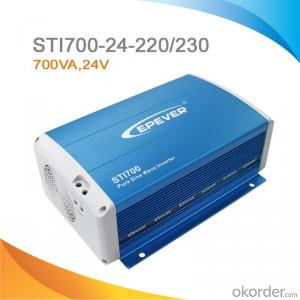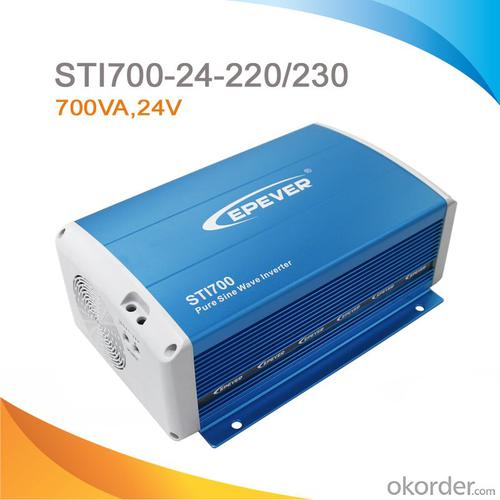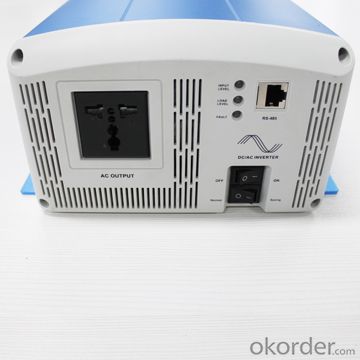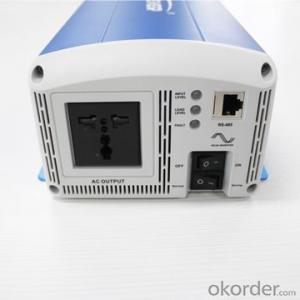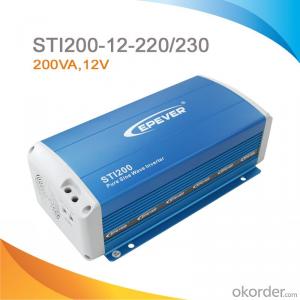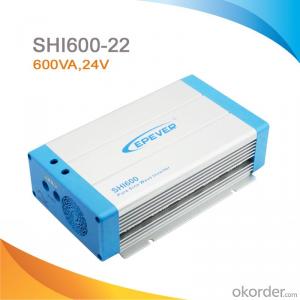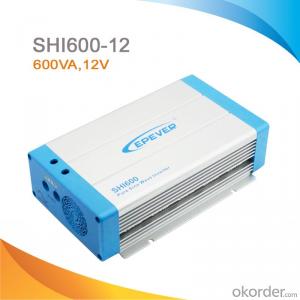Srne Solar Inverter - High Efficiency Off-Grid Pure Sine Wave Power Inverter 700W, 24V-220V/230V, STI700
- Loading Port:
- China Main Port
- Payment Terms:
- TT or LC
- Min Order Qty:
- -
- Supply Capability:
- -
OKorder Service Pledge
OKorder Financial Service
You Might Also Like
Description
STI series is a sine wave power frequency inverter which can convert 12V or 24V DC to 220VAC or 230VAC 50Hz based on full digital and intelligent design. The inverter can be applied in many fields especially for solar photovoltaic power system.
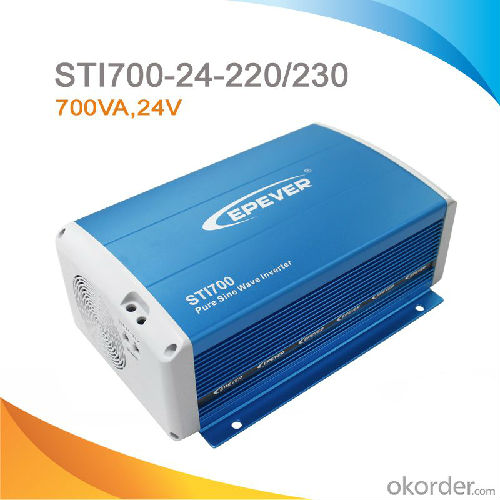
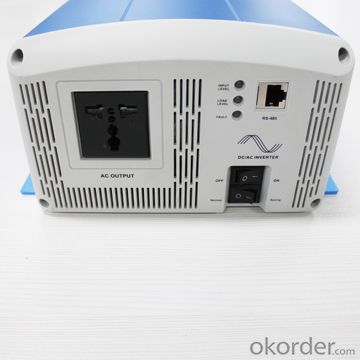
Features:
·Complete isolation-type inverter technology, noiseless output
·Adoption of advanced SPWM technology, pure sine wave output
·Dynamic current loop control technology to ensure inverter reliable operation.
·Wide DC input voltage range
·Excellent EMC design
·Low output harmonic distortion(THD≤3%)
·LED indicators display input voltage range, load power range, normal output & failure state
·Optional energy saving mode
·Wide working temperature range (industrial level)
·Continuous operation at full power
Protections:
·Output Short Circuit protection
·Overload protection
·Input reverse polarity protection
·Input low voltage protection
·Input over voltage protection
·Inverter abnormal protection
·Overheating protection

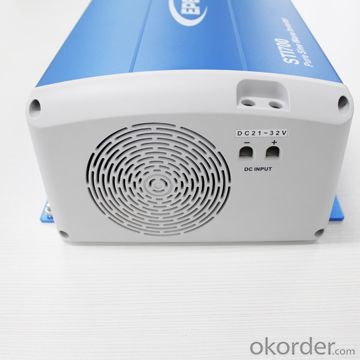
Specification:
Types | SHI600-12 | SHI600-22 |
Nominal Battery Voltage | 12V | 24V |
Input Voltage Range | 10.8~16Vdc | 21.6~32Vdc |
No Load Current | ≤0.7A | ≤0.45A |
Output Wave | Pure Sine Wave | |
Output Voltage | 220Vac±3% / 230Vac±10% | |
Continuous Power | 600W | |
Power 10 sec | 900W | |
Power 1.5 sec | 1200W | |
Surge Power | 1350W | |
Frequency | 50/60Hz±0.2% | |
Distortion THD | ≤ 3% (resistive load) | |
Efficiency at Rated Power | ≥91% | ≥92% |
Max. Efficiency | ≥93% | ≥94% |
Terminal | 25mm2 | |
Dimensions | 295×186×82mm | |
Installation | 150×178mm | |
Hole Size | Φ6mm | |
Net Weight | 2.3kg | |
Working Temperature | -20℃~ +50℃ | |
Storage Temperature | -35℃~ +70℃ | |
Humidity | < 95% (N.C.) | |
Altitude | < 5000m(Derating to operate according to IEC62040 at a height exceeding 1000m) | |
Insulation Resistance | Between DC input terminals and metal case: ≥550MΩ; Between AC output terminals and metal case: ≥550MΩ. | |
FAQ
Off Grid VS On Grid Panels, what's the difference?
The differences between both panels are related to the system where they are going to be installed.
On-grid installations, as the name said, are thought to feed the produced energy into the grid and for that it is important to have the biggest voltage that it is allowed (1000VDC in Europe, 600 VDC in USA). For a defined power, more voltage means less current (P=V*I) and less losses.
In off-grid installations it is different because you must storage the energy into batteries. Batteries usually work at 12, 24 or 48 VDC and off-grid photovoltaic modules work at the maximum power point (mpp) near this voltage (see the datasheets). So the controller that charges the batteries works also near the batteries voltage.
Your limiting factor here is going to be this controller. You have to see what is the maximum voltage and the maximum current that it can work with, upstream (photovoltaic modules) and downstream (batteries andinverter). Then you have to dimension your PV array (Voltage and Current).
Does inverter long warranty mean high quality?
SMA did bump up the warranty to 10 years when CSI demanded all inverter manufacturers to do so. The European Sunny Boys are only warrantied for 5 years.
iPhones only have a one year warranty. Does that mean Apple products aren't reliable? Enphase offers a 25 year warranty on theiribut only one year on their inverters monitoring. Does this mean their monitoring is not as reliable as their inverter? Of course not.
Offering long warranties have very real costs, especially for publicly traded companies like SMA. If we were to offer a 25 year warranty, we would have to hold a higher reserve on our balance sheet, making our products more expensive. We think that our customers would rather have our high quality products at a lower cost.
Start-ups invariably offer long warranties to make up for lack of track record or the perception of quality problems. As the unfortunate recent events at Solyndra have shown, long warranties offered by start-ups can have limited practical value.
Analogies can be drawn to the wind industry: in the early days, customers requested very long warranties (20 years or so), since it was the wild west and no one had a clue about long term O&M requirements for these big new turbines. Now that the wind industry has matured, turbine warranties are again very short (2 years is typical) since the large suppliers have a track record of shipping quality product that does not fail when properly maintained. You could say that PV today is like the wild west environment in wind 10 years ago.
- Q: Can a solar inverter be used with a remote monitoring system?
- Yes, a solar inverter can be used with a remote monitoring system. In fact, many solar inverters are designed to be compatible with remote monitoring systems, allowing users to monitor their solar energy production, system performance, and troubleshoot any issues remotely. This enables better control and management of the solar power system, ensuring optimal efficiency and performance.
- Q: What is the typical lifespan of the capacitors in a solar inverter?
- The typical lifespan of capacitors in a solar inverter can vary depending on various factors such as the quality of the capacitors, operating conditions, and maintenance practices. However, on average, capacitors in a solar inverter are expected to have a lifespan of around 10 to 15 years.
- Q: How does a solar inverter communicate with other devices in a solar power system?
- Various communication protocols and interfaces facilitate the interaction between a solar inverter and other devices in a solar power system. One commonly used method involves wired connections, where communication interfaces like RS485 or Ethernet establish a direct link between the inverter and devices like solar panels, batteries, and monitoring systems. In addition to wired connections, wireless communication methods are also employed. Technologies such as Wi-Fi, Zigbee, or Bluetooth allow the inverter to establish connections with nearby devices. This wireless communication primarily serves monitoring and control functions, granting users remote access to manage their solar power system. Effective communication between the solar inverter and other devices is pivotal for optimal performance and efficiency of the solar power system. Vital data, including voltage, current, and temperature, is transmitted from the solar panels to the inverter. This information is critical for achieving optimal power conversion, as the inverter adjusts its operations based on these readings to maximize power output and ensure system safety. Moreover, communication with devices like batteries enables the solar inverter to efficiently manage charging and discharging cycles, optimizing energy storage and utilization. This ensures that surplus energy generated by the solar panels is effectively stored in the batteries and utilized during periods of low sunlight. In conclusion, the communication capabilities of a solar inverter are essential for integrating and coordinating various components within a solar power system. They enable efficient power conversion, monitoring, and control, ultimately maximizing the performance and advantages of solar energy generation.
- Q: Can a solar inverter be used in a building-integrated photovoltaic system?
- Yes, a solar inverter can be used in a building-integrated photovoltaic (BIPV) system. The solar inverter is an essential component in a BIPV system as it converts the direct current (DC) generated by the photovoltaic panels into alternating current (AC) that can be used to power the building's electrical loads or fed back into the grid.
- Q: What is the role of a power management system in a solar inverter?
- The role of a power management system in a solar inverter is to efficiently convert and manage the electricity generated from solar panels. It regulates the flow of power, optimizes energy production, and ensures the safe and reliable operation of the solar inverter system. Additionally, it provides protection against overvoltage, overcurrent, and other electrical faults, maximizing the overall performance and longevity of the system.
- Q: Grid-connected inverter is generally divided into photovoltaic power generation grid-connected inverter, wind power grid-connected inverter, power equipment and grid-connected inverter and other power generation equipment power generation inverter.
- The grid inverter is a current source, the output voltage is basically the grid voltage, may be slightly raised.
- Q: Can a solar inverter be used with solar-powered emergency backup systems?
- Yes, a solar inverter can be used with solar-powered emergency backup systems. A solar inverter is an essential component in converting the direct current (DC) generated by solar panels into alternating current (AC) that can be used to power appliances and devices. By connecting the solar inverter to a solar-powered emergency backup system, the excess solar energy can be stored in batteries or fed back into the grid, providing a reliable source of electricity during power outages or emergencies.
- Q: Can a solar inverter be connected to a battery backup system?
- Yes, a solar inverter can be connected to a battery backup system. This allows for the excess solar energy generated during the day to be stored in the batteries for use during times when there is less sunlight or during power outages.
- Q: How does a solar inverter interact with a battery storage system?
- A solar inverter interacts with a battery storage system by converting the direct current (DC) generated by the solar panels into alternating current (AC) that can be used to power household appliances or be fed back into the grid. It also manages the charging and discharging of the battery, ensuring efficient energy storage and utilization.
- Q: Are all solar inverters compatible with all solar panels?
- No, not all solar inverters are compatible with all solar panels. The compatibility between inverters and panels depends on factors such as voltage, power output, and technology. It is important to ensure that the inverter and solar panels are compatible to optimize the performance and efficiency of the solar energy system.
Send your message to us
Srne Solar Inverter - High Efficiency Off-Grid Pure Sine Wave Power Inverter 700W, 24V-220V/230V, STI700
- Loading Port:
- China Main Port
- Payment Terms:
- TT or LC
- Min Order Qty:
- -
- Supply Capability:
- -
OKorder Service Pledge
OKorder Financial Service
Similar products
Hot products
Hot Searches
Related keywords
